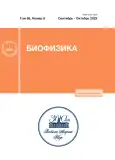High- dose nitric oxide gas inhalation for HIV infection
- Авторлар: Pekshev A.V1, Vagapov A.B1, Sharapov N.A1, Vanin A.F2
-
Мекемелер:
- N.E. Bauman Moscow State Technical University
- N.N. Semenov Federal Research Center for Chemical Physics, Russian Academy of Sciences
- Шығарылым: Том 68, № 5 (2023)
- Беттер: 1074-1080
- Бөлім: Articles
- URL: https://journals.rcsi.science/0006-3029/article/view/233485
- DOI: https://doi.org/10.31857/S0006302923050289
- EDN: https://elibrary.ru/NBAREQ
- ID: 233485
Дәйексөз келтіру
Толық мәтін
Аннотация
Негізгі сөздер
Авторлар туралы
A. Pekshev
N.E. Bauman Moscow State Technical UniversityMoscow, Russia
A. Vagapov
N.E. Bauman Moscow State Technical UniversityMoscow, Russia
N. Sharapov
N.E. Bauman Moscow State Technical UniversityMoscow, Russia
A. Vanin
N.N. Semenov Federal Research Center for Chemical Physics, Russian Academy of Sciences
Email: vanin.dnic@gmail.com
Moscow, Russia
Әдебиет тізімі
- М. Р. Бобкова, ВИЧ-инфекция и иммуносупрессии, 12 (1), 22 (2020).
- S. Kramer-Hammerle, I. Rothenaigner, H. Wolff, et al., Virus Res., 111, 194 (2005).
- T.-W. Chun, D. C. Nickle, J. S. Justement, et al., J. Infect. Dis., 197 (5), 714 (2008).
- S. Castro-Gonzalez, M. Colomer-Lluch, and R. Serra-Moreno, AIDS Res. Human Retroviruses, 34 (9), 739 (2018).
- C. S. Reiss and T. Komatsu, J. Virol., 72 (6), 4547 (1998).
- M. R. Garren, M. Ashcraft, Y. Qian, et al., Appl. Mater. Today, 22, 100887 (2021).
- F. Lisi, A. N. Zelikin, and R. Chandrawati, Adv. Sci., 8 (7), 2003895 (2021).
- F. Sodano, E. Gazzano, R. Fruttero, et al., Molecules, 27, 2337 (2022).
- T. Persichini, M. Colasanti, M. Fraziano, et al., Biochem. Biophys. Res.Commun., 254, 200 (1999).
- J. B. Mannick, J. S. Stamler, E. Teng, et al., J. Acquir. Immune Defic. Syndr., 22 (1), 1 (1999).
- T. Persichini, P. Ascenzi, V. Colizzi, et al., Int. J. Mol. Med., 4, 365 (1999).
- J. L. Jimenez, J. Gonzalez-Nicolas, S. Alvarez, et al., J. Virol., 75 (10), 4655 (2001).
- D. Torre, A. Pugliese, and F. Speranza, Lancet Infect. Dis., 2, 273 (2002).
- Е. В. Печёнкин, А. В. Коврижкин, А. В. Пекшев и др., Биофизика, 67 (6), 1251 (2022).
- А. Ф. Ванин, А. В. Пекшев, А. Б. Вагапов и др., Биофизика, 66 (1), 183 (2021).
- А. Ф. Ванин, А. В. Пекшев, Е. В. Печёнкин и др., Биофизика, 68 (1), 142 (2023).
- J. Z. Li, B. Etemad, H. Ahmed, et al., AIDS, 30 (3), 343 (2016).
- S. Khan, M. Kayahara, U. Joashi, et al., J. Cell Sci., 110, 2315 (1997).
- А. Ф. Ванин, А. А. Абрамов, А. Б. Вагапов и др., Биофизика, 68 (6) (2023) (в печати).
- А. В. Шиповалов, А. Ф. Ванин, О. В. Пьянков и др., Биофизика, 67 (5), 969 (2022).
- A. F. Vanin, V. A. Tronov, and R. R. Borodulin, Cell Biochem. Biophys., 79, 93 (2021).
- A. L. Kleschyov, S. Strand, S. Schmitt, et al., Free Rad. Biol. Med., 40, 1340 (2006).
Қосымша файлдар









